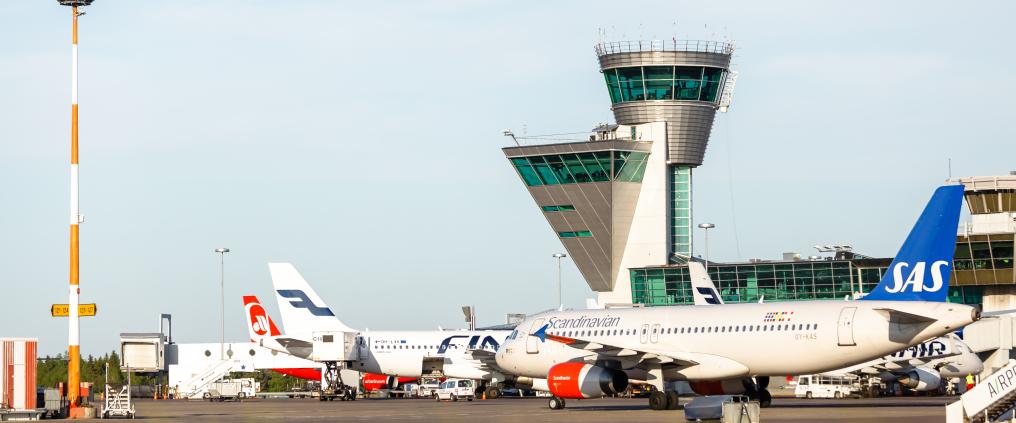At airports all around the world, aircraft stands are allocated daily based on flight schedules and airport data. Calculations for these allocations – which comprise aircraft activities such as arrival, departure and intermediate parking – are made to facilitate smooth operations for airlines and handling agents on the one hand, and ensure airport safety and passenger convenience on the other. How can peak-hour operations be further optimised, taking into account limited resources, unpredictable weather and other constraints?
We use a mathematical algorithm to optimise aircraft parking at two Finavia airports: Helsinki Airport and Kittilä Airport. These airports are very different but both are helped by the same technology.
“At Helsinki Airport, allocating aircraft stands has grown very complicated, and computers can help the employees do it effectively. The number of gates has increased over the past few years, and there are rules regulating what plane can be assigned to which of the airport’s 100 stands. Then add the preferences of airlines and commercial partners to the mix – all while maintaining safe and efficient passenger flows throughout – and everything becomes even trickier,” says Finavia’s CIO Leyla Akgez-Laakso, describing the background of the solutions.
When a computer makes the plan at Helsinki Airport, it opens up the possibility of preparing for different scenarios. The algorithm can build several alternatives and offer the best possible stand allocation when, say, the weather is bad or if parts of the airport are closed.
Serious mathematics to the rescue
At Kittilä Airport in Northern Finland, the peak season is around Christmas, with close to 60 flights arriving and departing on the busiest days. At this airport, which has excellent connections to major holiday attractions and ski resorts in Lapland, a shortage of parking spots is only one of the issues. The airport constantly needs to look for ways to provide enough buses, staff and check-in counters to meet the increase in air traffic during this peak season.
“When it comes to Kittilä Airport, the AI application has cut the calculation time from three hours to 30 seconds. The new parking plan created by the solution has already proven to be more robust against schedule changes. It has also improved collaboration and simplified coordination between different parties at the airport,” Akgez-Laakso points out.
Furthermore, the algorithm has allowed for greater transparency at both airports: parking spots, planes and buses are now shown on a single screen, which makes it easy to understand what is happening at the airport at a glance. Its use has likewise enabled lower CO2 emissions – the likelihood that a plane has to circle the airport before a parking space becomes available has been reduced, saving tonnes of fuel.
Solutions for passengers, airport operations and commercial partners
In terms of digital development, Finavia is concentrating on two fronts. Digital solutions for passengers mainly consist of communication channels and solutions like chatbots, web pages and applications. In addition, parking booking is being streamlined and website accessibility is being improved.
Another area, and a theme that will continue to be important in the years to come, is the continuous development of digital solutions to improve the efficiency of our key operations. The key operations also include efficient resource allocation.
Algorithm use and situational awareness are two of Finavia’s key digital projects.
“We have noticed that algorithm-based thinking is something that other airports could also use to optimise their workforce or fixed assets and thereby save money. We are now looking into cooperation with different groups and the commercialisation of our intellectual property rights,” says Akgez-Laakso.
As far as operational effectiveness is concerned, the main development has been done around the AOS (Airport Operational Status) tool. It provides future tools for airport operations with situational awareness: how the airport performs, how it can prepare for operative challenges and how data can be harnessed to make better choices.
To support this operational status tool, Finavia is developing machine vision.
“With machine vision, we will be able to calculate how many persons are going through the so-called process points, such as security control, and how long it takes them to do so. This is done with a video feed captured from a bird’s eye view and real-time visualisation. Real-time situational awareness allows us to make calculations for future efficiency reporting and planning activities.”
In addition, Finavia can provide certain services for its partners, such as directing passenger flows as needed.
“If we know that passengers of certain airlines are more likely to be interested in particular brands of our partners, we may decide to park those planes near those stores. This allows the passengers to walk through that part of the airport when they proceed to security control, for example,” Akgez-Laakso notes.
“The COVID-19 crisis has made it clear that efficiency is even more important for us. Efficient operations at our airports enable a fast and smooth experience for the customer and directly impact customer satisfaction. Digital solutions will continue to help us automate processes and make them more efficient,” Akgez-Laakso says.
There is a limit to how much the efficiency of people-centric processes can be increased. When you want to scale up and handle larger numbers of passengers, you need technology and automation. Technology will be the key enabler for sustainable growth.
This article has been compiled on the basis of the article published in the Manufacturing Technology Insights magazine Digital technologies will be the key enabler for Finavia’s growth.
Edited 8.6.2021.





